Estimated reading time 12 minutes, 38 seconds.
Within days of Russia’s invasion of Ukraine in February, a CC-130J Hercules was on the ramp in Prestwick, Scotland, ready to airlift much needed munitions and other equipment to the Ukraine border.
The transport aircraft, aircrew, and support personnel were the initial footprint of a Tactical Air Lift Detachment (TAL Det) that quickly grew to two Hercules and four aircrews, working almost nonstop for over two weeks to transfer donated aid to Ukrainian forces.
“Things escalated relatively quickly,” said Maj Cameron MacKay, the commander of the first TAL Det and a Hercules pilot with 436 Transport Squadron with over 3,000 hours on the J-model.
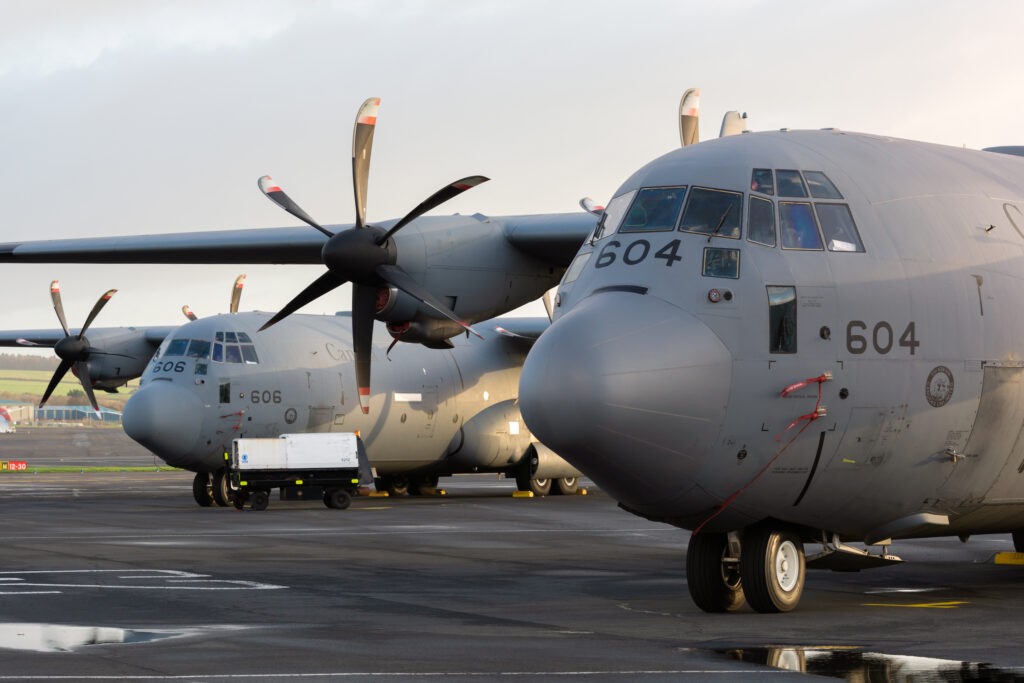
The process for deploying a forward-located hub to support Canadian and NATO airlift operations began within a day of Russia’s advance across Ukraine’s borders on Feb. 24. After determining the available aircraft and other resources, MacKay was “out the door with two full flying crews, support personnel, and one CC-130J” on Feb. 28 to set up the detachment. A second Hercules with two more aircrews and the remaining support personnel departed two days later.
The Glasgow Prestwick Airport, on the western coastline of Scotland, was among several locations in Europe under consideration, but was selected for its familiarity as much as its strategic position.
“It’s a very common spot for us to stop, rest, and fuel up when we’re going across the ocean, whether it’s into Europe or further on from Europe,” said MacKay. “Any of the aircraft in our fleet – the CC-177 Globemaster, the CC-150 Polaris, or the CC-130J — could get to Prestwick in approximately 12 hours. From a sustainment perspective, from an infrastructure perspective, it was a good fit.
“I have been flying in and out of Prestwick for many years, so I had an idea of where we could establish office space and so forth,” he added. “The familiarity of Prestwick allowed us to set up the operation quickly and start executing almost immediately.”
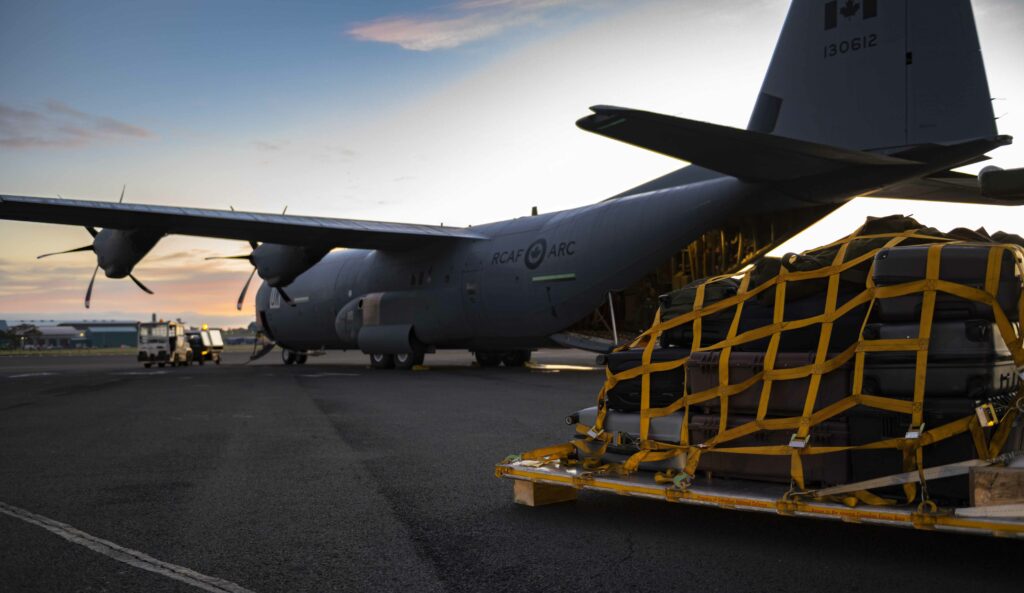
The stand up of new Royal Canadian Air Force missions is often led by 2 Air Expeditionary Wing. However, with much of the necessary supporting infrastructure in place, the air mobility expertise at 8 Wing established the TAL Det internally. Accommodations, meals, and transport for approximately 50 personnel were quickly put in place, and a liaison officer began working with partner nations to determine which donors of equipment and munitions needed airlift support. Planners then began building a flying program.
“When we went out the door, we knew we were going to be supporting allies, but it wasn’t necessarily clear where the freight would be coming from or going to,” MacKay acknowledged. “Establishing all those logistics pieces relatively quickly allowed me to focus more on how we would get the airplanes from point A to point B to point C.”
One of the more challenging tasks was obtaining the necessary diplomatic overflight clearances. Approvals can take time to obtain, but the TAL Det did not always know the nature of their cargo until the day before a flight. In fact, it often changed in the 24 hours before takeoff.
“We had to be as proactive as we could with the countries we were going to fly over,” he said, which often meant providing a list of the likely items and then confirming before a flight. Some countries will not permit overflight of certain cargo, while others require it to fly a “very specified route, depending on the freight that’s onboard.”
That can make mission and flight planning a challenge, particularly when aircrews require European control validation.

“European airspace is very complex,” MacKay noted. “The scope of what we were moving was pretty broad, anything from lethal to non-lethal donations. That will change the highway in the sky that we were going to fly. It’s a lot of one-direction airways, and trying to get a flight plan validated can be a challenge, especially when you’re restricted to flying one very specific route. But the crews got very smart at it very quickly.”
He gave much of the credit to the overflights unit at 1 Canadian Air Division in Winnipeg, Manitoba. “They were the rock stars behind all of this. They worked with the defense attachés around Europe to put this together and get us those diplomatic clearances.”
The nature of the load — dangerous goods or non-dangerous supplies — also had a bearing on how the aircrew approached missions along the eastern border of Europe. Crews were briefed daily on the situation, but to date have not encountered a serious threat.
Hub and spoke
Once word circulated that two Canadian Hercules were on the ramp and ready for customers, the requests came pouring in. The TAL Det declared itself mission capable on March 2 and executed its first transport flight to an undisclosed location on March 3.
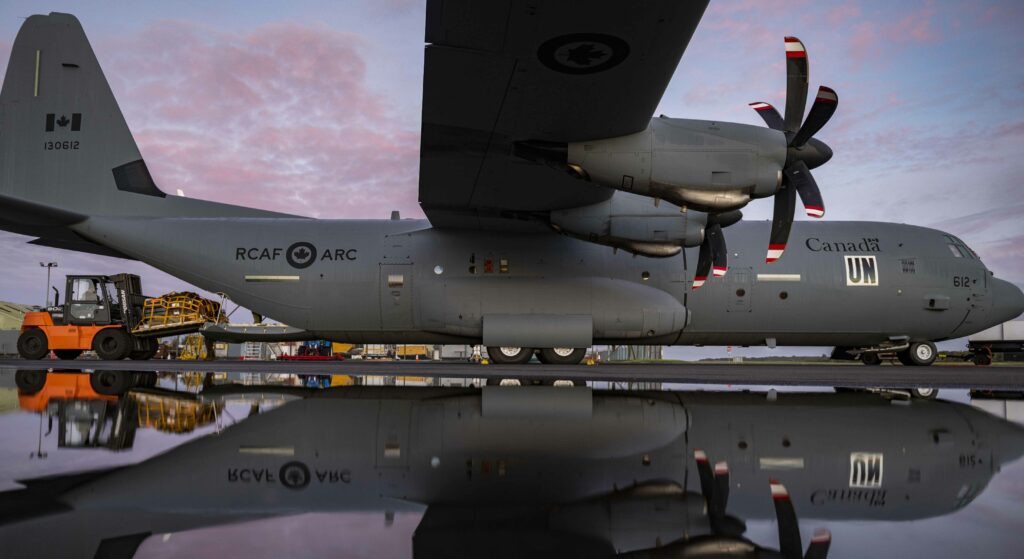
“I can’t say exactly where it went to or where it came from,” said MacKay, a 25-year veteran of the Canadian Armed Forces who originally joined as an infantry soldier. “But I can tell you that it was a lethal donation from a partner nation to one of a multitude of what we call ‘logistic enabling nodes,’ which is where it was offloaded to be moved across the border into Ukraine.”
From that point on, the detachment was flying almost “nonstop,” he said. “We could pretty much sustain 24-hour operations with the four crews that we had.”
In fact, the inside joke became the Energizer Bunny tempo of the team. “We just kept going and going,” said MacKay. “The airplanes were serviceable the whole time and the crews were well rested and super motivated to get the job done. They were very proud to be able to assist.”

Their flight path was dubbed the “Iron Triangle.” Although it varied based on the cargo, each CC-130J would start in Prestwick, fly to a location in Europe to pick up the load, and then to a second location to unload, before returning to Prestwick. Maintenance crews would then turn the aircraft around for a new crew to depart the next day. The pattern, visible on flight trackers, resembled a spider’s web of flights from the air mobility hub out along the many spokes throughout Europe.
Since the detachment often did not know the level of ramp support, they initially flew with a Mobile Air Movement Support (MAMS) team — the “heartbeat of air mobility,” said MacKay — with pallets, netting, and other support materiel to build up loads if necessary.
“The first time we went into a lot of places, we didn’t know what resources would be available when we landed,” he said, noting that on occasion there was little more than a broken cart being pulled by a tractor. MAMS teams were able to quickly repackage loads onto pallets to keep flights on schedule and crews within their allotted crew day.

For most of the first three weeks, the TAL Det operated at a frenetic pace with the two CC-130Js. When that was scaled back to one aircraft to balance air mobility resources supporting multiple global missions and training, the detachment still sought to maximize each flight. The aircraft would depart Prestwick for multiple days at a time and “move the equivalent amount of freight,” before returning to the Scottish hub.
The operation encompassed a lot more than just flying; the logistical aspect was critical. From the teams in charge of cargo management and movement, to the information systems technicians, to contracts officers… without their fast-paced response and dedicated work, the TAL Det would not have been possible, noted MacKay. Combined with the support from 8 Wing and the Air Mobility Division within the Combined Aerospace Operations Centre in Winnipeg, the mission was a team effort.
MacKay said the Canadian detachment quickly developed a reputation for reliability and flexibility, which has been a key factor in how transport flights are planned.

“Before you knew it, we’d hit a million pounds of freight moved,” he added. “By the time I left [in mid-June], we had flown just over 80 missions under my command and moved 2.4 million pounds of freight.”
In late September, the Canadian government announced the addition of a third CC-130J to assist with the airlift. The extra Hercules and the greater use of CC-177 aircraft to move cargo to Prestwick — or directly to European locations — prompted a name change; the TAL Det was renamed as Air Task Force Prestwick, which now supports not only Operation Reassurance, but also Op Presence (Africa) and Op Impact (Kuwait) as a true hub-and-spoke for air mobility operations.
By mid-October, the Air Task Force Prestwick had flown over 1,500 hours on more than 200 missions, and by mid-December, had transported over 5.6 million pounds of cargo.
That volume of cargo has included Canadian donations of M777 howitzers, M72 rocket launchers, hand grenades, Carl Gustaf M2 recoilless rifles, machine guns, pistols, carbines, sniper rifles, millions of rounds of various ammunition, night vision gear, helmets, body armor, and drone cameras, as well as ready-to-eat meals and winter clothing.
What impressed MacKay most was the steady flow of donations from both NATO and non-NATO partners. “The thing that stood out was the sheer volume and our ability to move as much as we did in the time we’ve been there,” he said. “You would think that eventually they’re going to run out of donations. But it hasn’t slowed down at all.
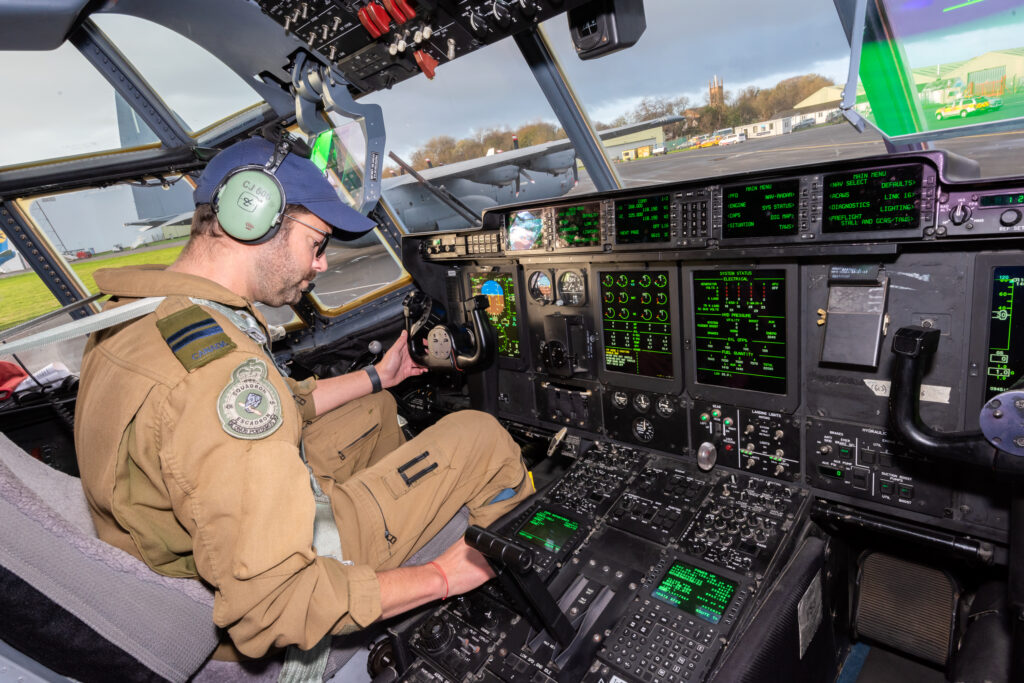
“It’s been pretty cool to watch from where it started to where it is now and how it’s grown,” he added. “For me, it holds a special place because I was so actively involved in getting this going, and I feel proud of what we have been able to do to date. Everybody was very motivated to participate. As soon as we got on the ground, we were ready to execute. It actually took us longer to find our first donating nation than to get ready to fly the airplane.”
Air Task Force Prestwick has been flying missions in Europe for over 10 months in support of Ukraine.
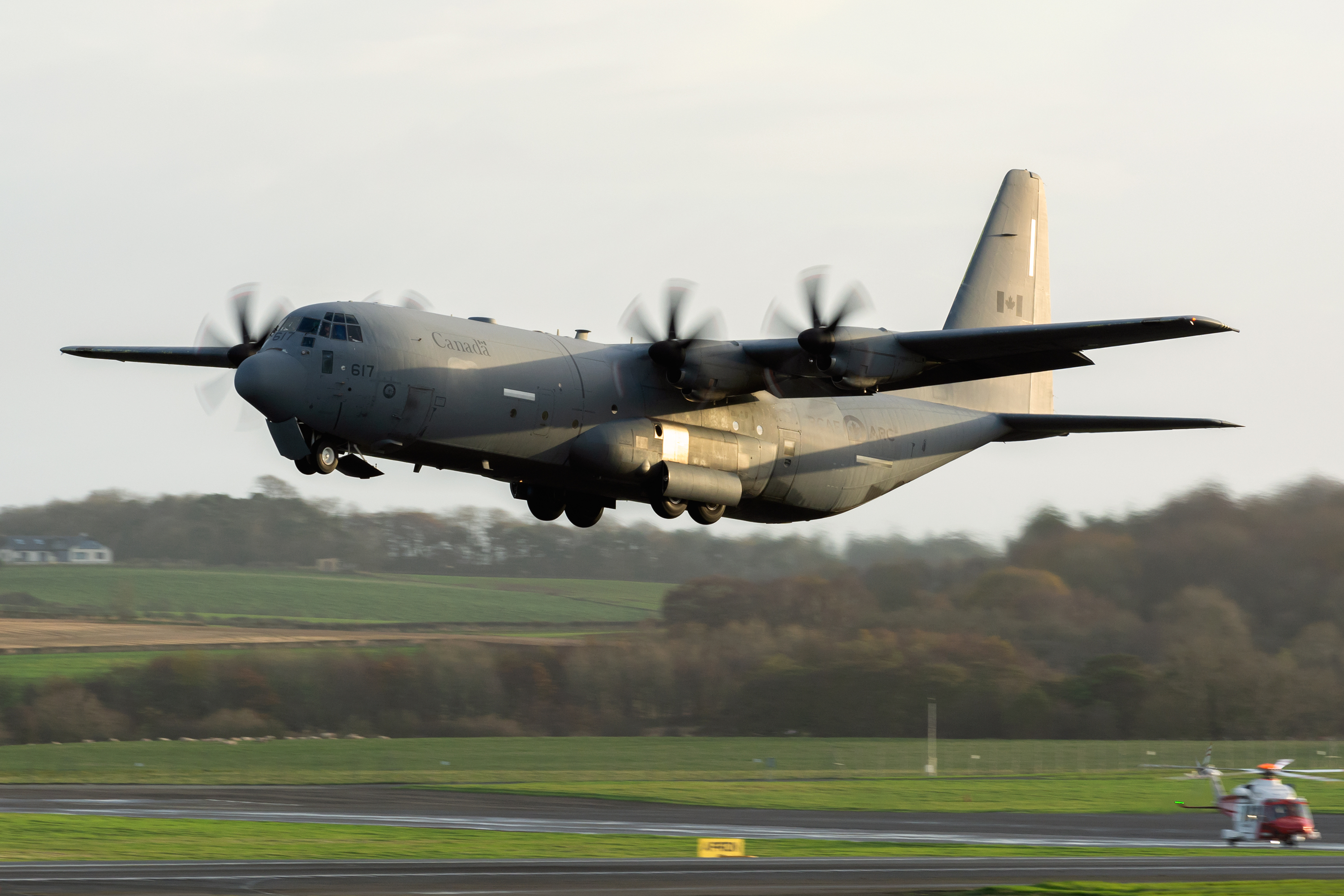

Just a Hi to Eric Greico . From LHR
Love the patch is there a chance of getting one